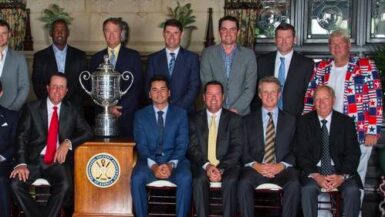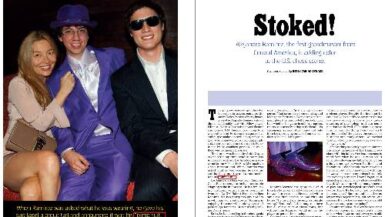When the second edition of attorney-turned-professor John “Jack” Minan’s “Little Book of Golf Law, 2nd Edition” came across my desk last week my first thought was “Oh no, not this guy again.”
Minan is a well-liked professor of law at the University of San Diego, a job he took after an impressive record as a practicing attorney, (he even worked a while at the Department of Justice). He’s also a nice guy, (I met him once, and he was charming and polite). But his published work in the golf field is problematic.
Minan’s first attempt at producing a book useful to attorneys who work with and for the golf industry was a triple bogey. Rather than a book that took the topic seriously – providing contracts, pleadings, business analysis, and covering transactional issues that lawyers that represent people in the golf industry could use – his “Little Book of Golf Law” was a confused mélange of poorly narrated golf stories, (occasionally woefully inaccurate), a fistful of cherry-picked cases, and incessant, non-sequitors trying to link the two together into some kind of humorous narrative. In each “chapter” Minan would tell a golf story. Then he would present a legal case and try to connect the case and the anecdote with either a “joke” or play on words that was neither clever nor truly related to the lawsuit in any way. Vapid things like “In the movie Caddieshack, Chevy Chase shanks a ball through Bill Murray’s window….shanking a ball into your playing partner can lead to liability.”
Ya think??!!
Then there are mindless attempts to be clever like “the defendant chipped over some legal hazards,” when someone escaped liability and “sometimes it can be dangerous to stop and smell the flowers,” when someone got hit by a golf ball walking past a golf course. It was as though he were writing to high schoolers, not attorneys.
“His writing style is awful,” opined one sports attorney. “His tone is chirpy. He insults my intelligence. I think the audience he’s playing to is people who like golf and aren’t bored by law discussion, but it’s not a book useful to lawyers who do this work every day or almost every day.”
Too short, too superficial, and too glib by half, the first edition was completely useless to entertainment and sports lawyers who practice the law of the golf industry as a part of their clientele. Law is a serious business, and Minan didn’t take his topic seriously enough.
The second edition is a bit better, but not by much. Many of the same problems persist: the ghastly writing style, the constant non-sequitors, the dumbed-down golf stories, the puerile tone he assumes, etc. This version has more cases, (that’s a plus), but again Minan only provides a superficial glossing over the topic for people interested in a little light law reading.
“Light law reading?” How many of those people are there?
“That looks boring,” said one golfer at my home club as he saw me reading it in the men’s grill room in preparation for this article. I tried to explain that some of the actual cases – Tiger Woods’ right of publicity, Casey Martin’s fight to ride a golf cart in tournaments where everyone else walked, or whether you can copyright a golf hole, for example – are pretty interesting…
“My God,” he gasped. “It’s even more boring than I thought,” he replied. “You lawyers are crazy, I’m going out to play now…” The message was clear: he thought this was a topic for beardpullers.
The member was right, actually. Minan’s book is a cutesy little thing to sell to his students and gain a little street cred on campus. But practicing lawyers don’t have time or use for cutesy, street cred, or beardpulling. We need a book that will be helpful to lawyers who practice sports law and in particular have golf industry clientele as clients. As Maximus famously said to Proximo, “This is not it…this is NOT it….”
The law and practice of the golf world is primarily contractual: contracts between course owners and architects, between networks and rightsholders, between players and managers, players and caddies, etc. There is also a significant amount of real estate, tax law, business formation, and intellectual property involved. There are even issues regarding steroid/PED policies that need to be addressed. Golf lawyers, and indeed sports lawyers in general, are almost exclusively transactionalists, and there is nothing transactional about “The Little Book of Golf Law.”
Worse still, there is little practical advice on how to represent golf courses, less still on advising golf course architects, and absolutely nothing on contracts between pro golfers and their business team members, courses and architects and their subcontractors, manufacturers and distributors. There is no discussion whatsoever about how the golf industry or golf tours work and conduct their business.
Here are some suggestions that would improve discussion of the topic significantly:
1. Can the dorky golf stories. The ham-fisted attempts to somehow link famous events in pro golf to some legal case that doesn’t actually involve the protagonists of the anecdote constantly dumbs down the book with vapidity and non-sequitors. They waste a lawyer’s most valuable asset – our time.
2. Ease up on the litigation and add transactional analysis. Breakdown of how the golf Tours operate, discuss the intellectual property rights of the manufacturers and how those rights are protected. Provide a detailed analysis of the issues in golf architecture. With such a heavy concentration on case law, his book should be called “Tort law for cases involving golf.” We sports lawyers need much more than that.
3. He missed three big cases – 1) Vijay Singh’s lawsit against the PGA Tour over his suspension from Tour on suspicion of Performance Enhancing Drugs, 2) Rory McIlroy’s suit against his former manager over the contractual terms of his management agreement, and 3) Sherrill vs. Turning Stone Casino – which involved the non-payment of local tax shenanigans of one of the PGA Tour’s venues.
4. Get an editor! It takes Minan eight pages to say what could be said in three. If he had an editor who would do what Ernest Hemingway said and, “ruthlessly delete the excess,” Minan’s book would be a third the size, but three times better.
5. Read some books on style, and check your ego at the door. Minan’s constant interjections ruin the flow of the narrative. He violates one of the cardinal laws of style set forth by the two greatest writing teachers, Strunk and White, who warned writers, “Do not adopt a breezt manner.” I get that legal writing destroys creative writing skills and that writers need to “stretch their legs” by unwinding on paper, but a law book isn’t the place for wild experimentation. Take the subject matter seriously so the reader does the same. Additionally, Minan wastes too much time overstating the obvious. We know that a golf ball to the head hurts, and don’t need a mindless observation that it ruined the golfers’ day.
6. Co-author the book with someone who does have the expertise needed to elevate the book to the practice standards the A.B.A. needs to provide to lawyers working in the industry. Jack Minan may love golf, but his book projects a limited understanding of golf and only a superficial sketch of litigation issues. We need something more practice oriented and more detailed to be useful.





